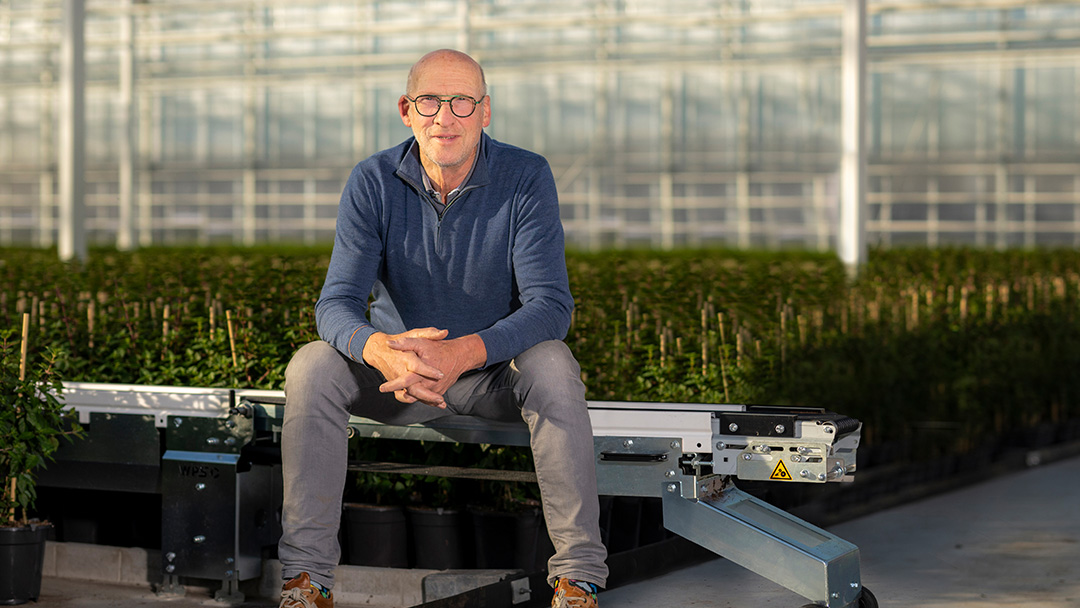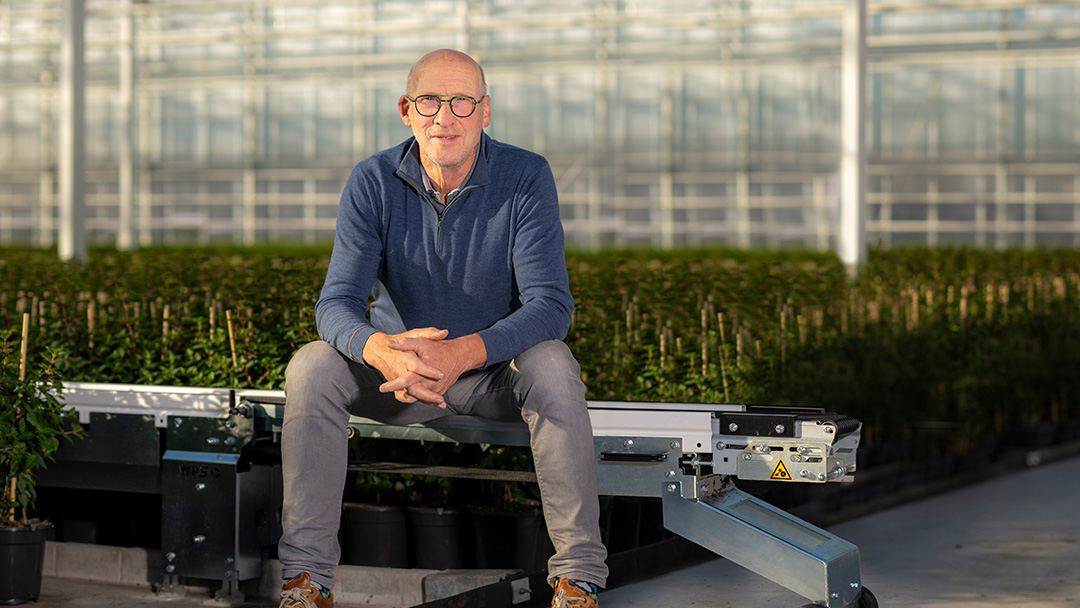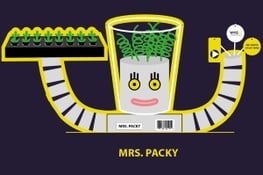Noordpoel Nursery invests in automation and WPS’s latest innovation: the Floormanager
De Kwakel, October 2025 – Noordpoel Nursery is taking a major step toward the future. At its...

Join us for a look at the life of this pioneer in the Dutch horticulture industry!
70 years
Evert van Zanten was born among the greenhouses on Heenweg in the heart of the Westland, the Netherlands’ foremost horticultural region, on 12 December 1951. After completing lower horticultural school, he enrolled in higher horticultural school, but soon realized that this was not what he wanted. Not being averse to hard work, Eef decided to go to work for a farmer.

Military service on Curaçao
When the time came for Eef to enlist in compulsory military service he was sent to Curaçao, which was completely different from the Westland. “On Curaçao, I discovered that I have an excellent aim. After some time, the officers let me shoot with a pistol. I ultimately became a military shooting champion. My sporting achievements were worth more to me than carousing with the others.”
Innovations
Back in the Westland District, Eef met Gerrina and a few years later they were married. In the meantime, Eef had started working at a plant nursery and also spent a short time working for a contractor who went bankrupt. This marked a new phase in Eef’s life. Instead of applying for a job elsewhere, he decided to start his own business. This resulted in Eef, Frans and another colleague founding Le-En-Za in 1982. The third business partner left after some time, but Eef and Frans stayed on, doing contract work for growers like filling crates with vegetables.
At that time, Eef was already working on some innovative inventions, albeit on a small scale. Constantly looking for ways to improve the efficiency of the jobs he was doing, he came up with some great ideas such as a trolley on which vegetable crates could be conveyed.
Eef: “You could also ask the grower for those crates, but then you had to keep getting up to fetch them.” And so Eef and his partner picked up the crates by themselves, on a trolley they had fabricated. “It was actually a very simple invention. But it made our work much easier.” A competing company caught onto the idea and immediately started copying their trolley.
Rockwool mats
Eef and Frans then decided to try something new. They started supplying rockwool mats on a large scale to growers throughout the region. The two men just happened to be in the right place to spot a big gap in the market. Growers started making the switch from soil to rockwool as a substrate in huge numbers, and the company founded by Eef and Frans grew so quickly that they soon employed a workforce of 75! Not only did they have a good product in their hands; it also served as a gateway for useful information. “Because we traded in rockwool, we were always among the first to discover what was going on in the horticulture sector and what growers needed.”
In only a short time, Eef and Frans launched three innovative products that would change the horticulture industry forever: plugs, gutters and conveyor belts. The company changed its name Le-en-Za to Preforma.
Stabilized growing media
In 1988, Eef and Frans started making stabilized growing media. These were made by mixing polyurethane with potting soil. “We poured that mixture into trays. Seedlings could then be planted into the stabilized growing media for further growth. That way you could pull the plant out later, roots and all, without damaging the roots.”
The advent of stabilized growing media paved the way to further automation in the horticulture industry. “A machine could pull out those plugs in no time at all.” Technological advancements were following rapidly on one another in the horticultural sector at that time. Eef: “That was partly thanks to the spirit of amicability in the horticulture sector at the time. Growers were happy to share things with one another. As a result, the sector was undergoing tremendous advancement as a whole.”
Gutters
Many years ago, gerberas were grown on ridges of soil – until they saw growers making use of gutters to collect excess water. However, when they tried putting rockwool mats on these gutters, it quickly became clear that this would not work. “When a rockwool mat gets wet, the risk of contamination from one plant to another is high. Infections spread quickly through the water and, before you know it, your entire greenhouse is affected. That also happened in the case of the gerberas.”
“We can do better,” thought Eef and Frans, and they started making gutters with a raised bottom. “This allowed the water to run underneath the rockwool mats, thus preventing them from getting too wet.” The only problem was that this solution did not work for the gerberas but, considering that this was an improvement, a machine was developed to produce these steel gutters. One of the biggest advantages to using gutters is that they allow growers to independently determine the slope. The first success story involving these gutters was achieved with strawberries. Strawberry farmers were already using gutters made from zinc, but zinc in water is not good for plants.
After ten years of success in the strawberry-growing industry, Eef came into contact with a tomato grower who was having a lot of trouble with the wet soil under his crop. The Preforma duo showed the grower the strawberry greenhouses with their hanging gutters, and the man was convinced that this was the solution he was looking for straight away. “He decided to suspend his tomatoes higher too, and immediately ordered some gutters from us. Because the water could now be collected in the gutters, the soil in the greenhouse became a lot less humid.” That was a great start. After that, competitors also started producing gutters and Preforma merged with Metazet to become FormFlex.
Conveyor systems
The third invention devised by Frans and Eef that turned out to be a great success was the plant conveyor system. “The idea was not ours, initially. But we turned that invention into a big success.” Eef came into contact with the Valstar plant nursery in Roosendaal, purely by chance, when working on a project there. “So, this man said to me: ‘I have something that might interest you’. And he showed me his latest invention. He had put a car seatbelt in a gutter, which was set in motion by a little machine. This allowed him to move his plants along the gutter.” Although this worked in theory, the system kept crashing and Mr. Valstar did not know how to solve this problem.
Eef instantly identified the problem. “A plastic gutter is unstable. You need a steel gutter for a system like this.” Fortunately for Eef and Frans, Mr. Valstar was done messing about with his invention. “He said: ‘Take that thing away’,” recalls Eef. So, Eef took all the parts of this machine home with him and started working on it. And, just as he predicted, using a steel gutter did the trick. “I went back to Roosendaal and told Mr. Valstar that I had succeeded in getting his invention to work.”
He immediately asked Eef to install 80,000 feet of gutters, equipped with seatbelts, in his plant nursery. That is a lot, but it became the perfect pilot project to gauge if this system would work on a larger scale. With the promise of a percentage of the profit as a condition, Eef and Frans were now fully prepared to make the system a success.
Eef: “The system proved to be a breakthrough in the field of potted plants. Growers with a conveyor system like this could produce many more plants per square foot. Not only that; it leads to a reduction in heating costs. The more plants you have in a given area, the easier it becomes to keep it at the right temperature. In other words, you will achieve a reduction in heating costs per plant.”
The OPC
Eef and Frans established Walking Plant Systems (WPS) and, of course, soon started expanding their product range. “We were soon asked if we could also make delivery systems, and we had a camera system developed to facilitate the grading of plants. Those cameras scanned the plants on criteria like the number of flowers, the color of the flowers or the length of a plant.”
This was also when Eef developed the Carrier. “This is a small carrier made of plastic. You can use it to convey plants. There are two distinct advantages to this system: you can easily integrate a tag into it and it provides plants moving along the conveyor belt with more stability. We call it the OPC: the Oval Plant Carrier.”
Frans and Eef then started to install conveyor systems and cameras for growers all over the country. They also provided all the pot plants with an electronic tag. “All the characteristics of a plant that are registered by the camera are subsequently recorded in that tag.” They applied for a patent on the Carrier, and decided to keep the invention to themselves rather than sharing it with others. “We are the only company that makes these carriers. WPS is, in fact, still doing this today.”
From innovation to manager of WPS in De Lier
In the meantime, Frans decided to retire and, in time, a number of innovations were sold and shares transferred. Eef stayed on at WPS, primarily in the capacity of manager and director. He handed over the leadership of WPS to his daughter Digna in 2018. That she would take over the leadership of the company from her father was never written in the stars.
“When I was about fifteen years old, I could see myself doing this. My father sometimes said to me, jokingly: ‘Perhaps you will become the director of the company sometime’.” But when, years later, Digna expressed her ambition to take over WPS, it took some time for this plan to be made concrete. “My father always said: ‘I don’t necessarily want one of my daughters to take over WPS’. He never pushed me. Rather the opposite.”
Digna continues: “I am immensely proud of what my father has achieved, and that I can continue to bring innovations to the market. My goal is to fully automate the horticulture industry. I want to unburden growers completely through innovative solutions in the way of automation and logistics in order to give them more time for other things, in both their professional and personal lives.”

De Kwakel, October 2025 – Noordpoel Nursery is taking a major step toward the future. At its...

Danish company Gartneriet PKM, one of...